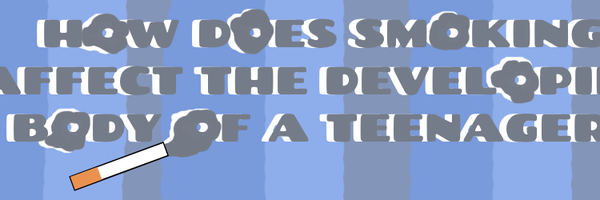How Does Nicotine Affect The Developing Body Of Teenagers
Grade 8
Presentation
No video provided
Problem
The problem with smoking is that it can lead to many long term health issues such as Cancer, bronchiolitis obliterans, strokes, heart diseases, lung diseases, diabetes, and much more. There is a plant commonly used in cigarettes and smoking devices called tobacco which contains a chemical called nicotine.This chemical speeds up messages traveling between the brain and the body. Nicotine can also stimulate the release of a chemical called dopamine which gets you addicted and you start using it non stop.
Method
Method:
-We surveyed 10 female grade 7-9 students who were past or current smokers from February to March 2024, to tell us reasons why they started smoking, how it made them feel, if they felt anything change, and how it made them feel after.
-Searched the internet for past publications,and articles about nicotine use among Canadian teenagers between 2018 and 2020 and its impacts
Research
Nicotine is used in cigarettes, e-cigarrettes (electronic cigarettes), pipes, cigars and more.
Nicotine can increase your blood pressure, heart rate, and the flow of blood traveling to your heart. It can also cause mood disorders and change the way you act. For example, it is said that it can make you feel relaxed, and or make you feel alert, but it also affects your memory, ability to concentrate, cause someone to feel nauseous and light-headed.
We had an idea that the amount of smokers would increase due to the Covid-19 pandemic which started in 2019, so we researched the amount of teens smoking 1 year before and after the pandemic. We found that from 2018 to 2020 the amount of smokers, who were age 12 and up, decreased from 4.9 million Canadians (15.8%) to 4.1 million (12.9%) so this information falsifies our idea.
Data
We got responses from all 10 students who were surveyed. All participants have used e-cigarettes. Most participants (80%) have stopped, while 20% were current smoker.
Reasons why: Majority, 8 of the 10 students were influenced by other students, 1 said that they thought it made them seem mature and 1 decided to use nicotine to relieve stress.
How it made them feel: all ten said that they got a buzzed feeling (headache) while using the e-cigarettes. 7 of them also had the nauseous feeling, while 3 of them felt calm and relaxed while doing it.
If they felt anything change: only 1 felt a change. They said it made them feel like a person again.
And how it made them feel after: 1 said when ever they smoked, it made them feel guilty so it was easy for them to stop. They ended up changing schools which contributed to their quitting
Conclusion
In conclusion, we found that the major driver for starting to smoke among Canadian teenagers was a result of peer pressure in the school environment. Secondly, in consistent with the online findings, smoking has mostly a negative effect on teens. We recommend that schools try to spread awareness of the dangers of smoking and regulate rules in school to stop smoking so teenagers will avoid trying or using cigarettes or e-cigarettes.
Citations
2018-2020 smoking: https://www150.statcan.gc.ca/n1/pub/82-625-x/2019001/article/00006-eng.htm
Statistics Canada 6/25/2019
Statistics Canada 11/6/2023
other:
https://my.clevelandclinic.org/health/treatments/21162-vaping
Cleveland Clinic 08/22/2022
https://www.niehs.nih.gov/health/topics/agents/smoke
National Institute Of Enviromental Health Sciences 2/20/2024
https://www.healthline.com/health/is-vaping-worse-than-smoking-cigarettes#dual-use
Carly Vandergriendt,Tess Catlett,Dena Westphalen, PharmD 1/22/2019
https://www.camh.ca/en/health-info/mental-illness-and-addiction-index/tobacco
2003, 2010 Centre for Addiction and Mental Health
https://kidshealth.org/en/teens/e-cigarettes.html
From:Nemours Children's Health, Reviewed by:Elana Pearl Ben-Joseph, MD 1/2024
Acknowledgement
To all participants and Hameedah's mom who all took their time to help us out with this research, thank you and we appreciate your efforts

